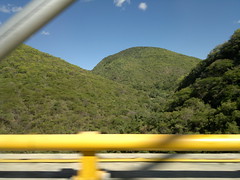Guerrero
Guerrero (Spanish: [ɡeˈreɾo]), officially the Free and Sovereign State of Guerrero (Spanish: Estado Libre y Soberano de Guerrero), is one of the 32 states that comprise the 32 Federal Entities of Mexico, located in Southwestern Mexico. It is divided in 81 municipalities. The state has a population of about 3.5 million people. It is bordered by the states of Michoacán to the north and west, the State of Mexico and Morelos to the north, Puebla to the northeast and Oaxaca to the east. In addition to the capital city, Chilpancingo and the largest city Acapulco, other cities in Guerrero include Petatlán, Ciudad Altamirano, Taxco, Iguala, Ixtapa, and Zihuatanejo. Today, it is home to a number of indigenous communities, including the Nahuas, Mixtecs, Tlapanecs, Amuzgos, and formerly Cuitlatecs. It is also home to communities of Afro-Mexicans in the Costa Chica region.
The state was named after Vicente Guerrero, one of the most prominent leaders in the Mexican War of Independence and the second President of Mexico. It is the only Mexican state named after a president. The modern entity did not exist until 1849, when it was carved out of territories from the states of Mexico, Puebla, and Michoacán.
Geographically, the state is mountainous and rugged with flat areas limited to small mesas and the Pacific coastline. This coastline has been important economically for the area, first as the port of Acapulco in colonial and post-Independence era and today for the tourist destinations of Acapulco, Zihuatanejo and Ixtapa. Tourism is the single most important economic factor of the state and Acapulco's tourism is important to the nation's economy as a whole. Agriculture and mining are also important to the state's economy, with production of crops like bananas, coffee, rice, corn, and sugarcane, as well as mined copper, sliver, and gold. However, other sources of employment are scarce in the state, which has caused its ranking as number one in the emigration of workers to the United States.
History
Prehistoric and Pre-Columbian periods
The first humans in the state's territory were nomadic hunter-gatherers who left evidence of their existence in various caves starting about 20,000 years ago. Until about 8,000 years ago, climatic conditions better favored human habitation than those today; however, sedentary human habitation happened around this time in the mountainous areas with more moisture, and better soil for agriculture. After that, settlements appeared near the coast because of fishing. At these sites, evidence of weaving, ceramics, basketry and other crafts have been found. Around this time, a grain called teocintle, or the forerunner to corn, became the staple of the diet.
There is debate as to whether the earliest civilizations here were Olmecs, who migrated to this region or native peoples who were heavily influenced by the Olmecs, especially in the Balsas River area. Olmec influences can be seen in cave paintings such as those found in Juxtlahuaca and Cacahuaziziqui as well as stone tools and jade jewelry from the time period.
Recent evidence indicates that ancient Guerrero cultures may have influenced the early development of the Olmecs.
Eventually, the peoples of the Mexcala River area developed their own distinctive culture, called Mezcala or Mexcala. It is characterized by its own sculpture and ceramics, distinguished by its simplicity. Olmec influence remained with this culture, especially evident in the grouping of villages, construction of ceremonial centers and a government dominated by priests. Later, the culture assimilated aspects of the Teotihuacan model, which included the Mesoamerican ballgame .
Later migrations to the area brought ethnicities such as the Purépecha, Mixtecs, Maya and Zapotecs who left traces on the local cultures as they established commercial centers around the seventh century. In the 8th century, Toltec influence was felt as they traveled the many trade routes through here in search of tropical bird plumage and amate paper. From the 12th century to the 15th, the various peoples of the state were influence by the Chichimecas, culminating in Aztec domination by the 15th century.
In the 11th century, new migrations entered the area from the north, which included the Nahuas, who occupied what is now the center of the state, and the Purépecha who took over the west. The Nahuas established themselves in Zacatula, Atoyac de Álvarez and Tlacotepec, later conquering the areas occupied by the Chontal Maya and Matlatzincas.
By the 15th century, the territory of the modern state of Guerrero was inhabited by a number of peoples, none of whom had major cities or population centers. The most important of these peoples where the Purépecha, Cuitlatecs, Ocuitecas and Matlatzincas in the Tierra Caliente, the Chontales, Mazatlecos and Tlahuicas in the Sierra del Norte, the Coixcas and Tepoztecos in the Central Valleys, the Tlapanecos and Mixtecs in the La Montaña, the Jopis, Mixtecos and Amuzgos in Costa Chica and Tolimecas, Chubias, Pantecas and Cuitlecas in Costa Grande. Most of these lived in smaller dominions with moderate social stratification. One distinctive feature of the peoples of this was the use of cotton garments.
The Aztecs began making incursions in the Guerrero area as early as 1414 under Chimalpopoca as part of the conquest of the Toluca Valley. Incursions into the Tierra Caliente came around 1433 under Itzcoatl who attacked the Cuitlatecos settled between the Teloloapan and Cocula Rivers. By 1440, the Aztec Empire controlled the north of the state, or the La Montaña area. Attempts to take the Costa Chica area began in 1452 against the Yopis, which failed. Various battles would be fought between 1452 and 1511 before most of the rest of the state became Aztec tributary provinces. The modern state of Guerrero comprised seven Aztec provinces.
Colonial period
During the Spanish conquest of the Aztec Empire, the last Aztec emperor, Cuauhtémoc (who was the son of a Chontal princess and Ahuizotl), came from Ixcateopan de Cuauhtémoc. After the fall of Tenochtitlan, there was little resistance by the peoples of the Guerrero area to the Spanish and a number of them, such as the Amuzgos, actively sided with the Europeans. In 1521, Rodrigo de Castañeda entered the Taxco area, while Gonzalo de Sandoval marched on the Chontal region, the Sierra del Norte, the Iguala valley and later the Costa Chica. Juan Rodriguz de Villafuerte took the Costa Grande area.
After the Spanish Conquest, the territory was part of the audencia or "court of royal law for indigenous peoples" called México, which initially consisted of the lands of the former Aztec Empire, which was then diminished somewhat when it became a province of New Spain. The Guerrero area was attractive to the Spanish mostly for its coast. The first Spanish Pacific port was at Zihuatanejo, used for trade, fishing and pearls. Another important area for the Spanish was Taxco for its minerals. The lands were divided into 76 encomiendas given to the conquistadors to exploit and "civilize" the mines, farmlands, forest and native peoples. Evangelization efforts were undertaken by the Augustinians in the Central Valleys, La Montaña and Tierra Caliente regions while the Franciscans took the northern areas, the Costa Grande and Acapulco.
Much of the population decline occurred in the first half of the 16th century when diseases brought by the Europeans, as well as brutal exploitation, killed many natives. This was particularly true in the Costa Chica region, which would lead to the importation of African slaves to the area. During this time indigenous political bodies called "pueblos" or "Indian Republics" arose, which were local entities that represented the Indians of that area before Spanish authorities. They are credited with being one of the forerunners of the current municipality system in the state. At their height, there were 213 such pueblos in the Guerrero territory.
During the colonial period, Acapulco became the main western port for New Spain, connecting this part of the Spanish empire to Asia. The Manila galleon came here each year, bringing silks and other merchandise from China, India and other Asian areas. Also on board were thousands of Asian slaves. These slaves and other Asian individuals that migrated of their own will during the colonial period form the basis of what is known as the "cuarta raíz" of Mexico.
On January 25, 1614, a delegation led by samurai Hasekura Tsunenaga, which included over one hundred Japanese Christians as well as twenty-two samurai under the shōgun Tokugawa Ieyasu, arrived from Japan to Acapulco as part of a mission to form closer relations with Catholic Europe. A fight soon broke out in which a Japanese samurai stabbed a Spanish colonial soldier. This was witnessed and recorded by historian Chimalpahin, who was descended from an Aztec nobleman. Some of Tsunenaga's delegation would stay and marry with the locals.
By the second half of the 18th century, few indigenous people survived and exploitation of those that were left took on more varied forms in indentured servitude. Acapulco became the most important city in the area, and its mayor governed much of Guerrero's territory. This territory then belonged into three intendencias or alcaldias–Puebla, Mexico and Valladolid, regions managed by a superintendent intended to root out corruption–and would remain so until the early Independence period.
Independence and the later nineteenth century
Peoples of the territory of Guerrero immediately supported the cause of Miguel Hidalgo y Costilla which would culminate with the Independence of Mexico. During the first part of the Mexican War of Independence, José María Morelos fought on the side of Miguel Hidalgo in the southern part of Mexico, including the Acapulco area and the Costa Grande. Filipino-Mexicans lead by Isidoro Montes de Oca, who were also against Spanish colonization, assisted in the general uprising. However, the insurgents we…
Looking for places related to Guerrero?
Those are other destinations to find places related to Guerrero:






















